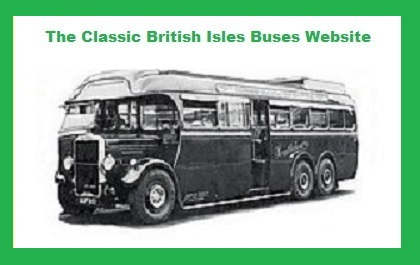

The Classic British Isles Buses Website
Clifford Jones's scrapbook (memories of a Southdown man) - part two (by Dick Gilbert)
Page last updated on 7 August 2024
Email Events diary Past events list Classified adverts Classic U.K. Buses Classic Irish Buses Classic Manx Buses
| Clifford Jones page 1 | Clifford Jones page 2 | Open-top utility Guy Arabs | Leyland Tiger pre-war coaches | Leyland Tiger pre-war buses | Leyland Tiger post-war vehicles | Underfloor-engined coaches 1951-1961 |
This page is a collection of memories and pictures from the fascinating bus career of Clifford Jones. It started with the preservation of a Southdown single decker and then a breakdown tender, continues with a bit of buying and selling, and later turns into a career managing and driving buses and coaches.
Here is the story of Clifford's life among the buses. All photos were supplied by Clifford unless otherwise credited.
Continued from Clifford Jones's scrapbook - part one
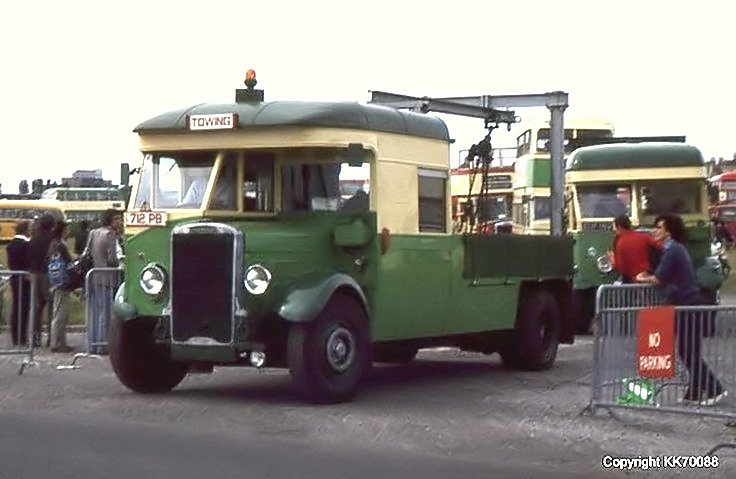
0181, 0182 and 248 at a Southsea rally in the 1970s.
"The photograph above shows 0181, 0182 and Southdown TD5 no. 248 (GCD 48) leaving a Southsea spectacular rally in the 1970s. I was about 30 in that picture and I am driving 0181. Pete Burton owned 0182 behind, and behind us is 248 with the owner, Gerry Bixley, driving. I took my p.s.v. test on that bus after I got it for Gerry from the Cobham Bus Museum."
"I learned how to take the test on GCD 248 in the evenings with my wife on the platform ringing the bell for start/stop at bus stops, reversing around a corner into a road and so on. When I took my test the examiner poked his head through the sliding window and said, you will have to drive faster than this Mr Jones, I need to see you travelling at least at 45 m.p.h. I didn't know what to say to him as TD5s were only built to do 40 m.p.h. and the emergency stop was hilarious. Thank God for push-on hand brakes, as I was standing up in the cab (on the brakes) and pushing on the hand brake as hard as I could! When he had passed me he said that he used to drive these types of buses. I think he confused them with post-war vehicles with air brakes."
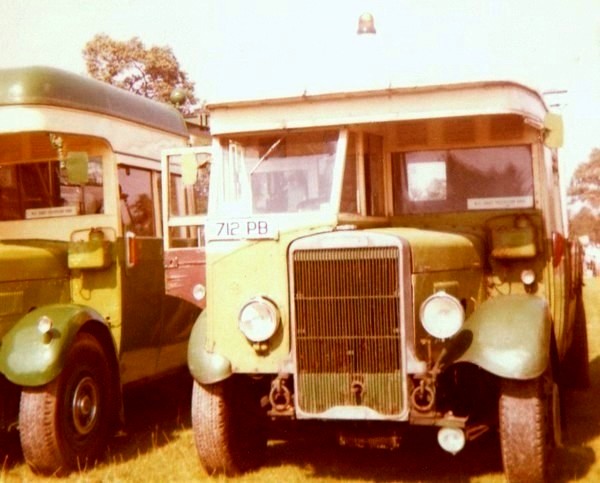
0181 with 0182 (left) at a Horsham rally.
"The photo above is at a rally at Horsham with 0182, which I went to without thinking how scruffy she looked. But I had my own trade plates by then so she was a workhorse. We are all retired now but have happy memories of restoring those vehicles and using them for towing and rallying them, as 0182 and 248 were seen at many venues."
"Southdown staff approached us at Battersea Park the following year - I was on a plane to America - as their Leyland G7 CD 7045 had failed. Peter Burton and Gordon Vane-Hunt were at Battersea park with 0182 as an entrant and 0181 as a tender in case they had to pick up a straggler on the way down as income. Southdown management had spoken to them and walked back from the gates to find them at the start. My colleagues asked, "Do you want it taken to Sammy's?." "No!", they said, "we don't want to go in there please - take us to Freshfield Road garage."
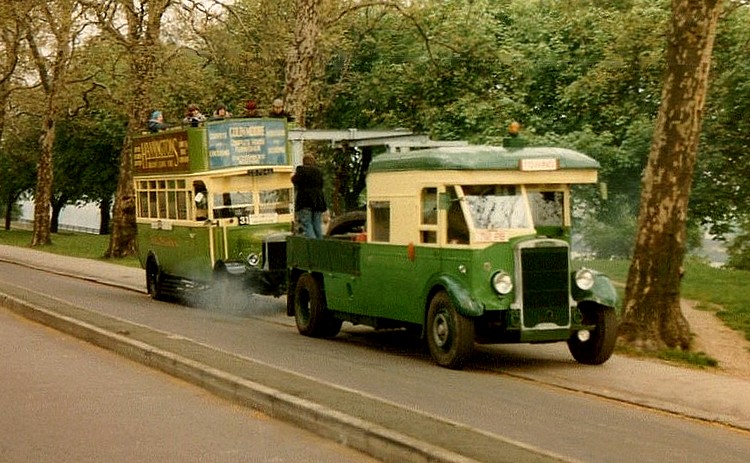
0181 rescuing Southdown G7 (CD 7045).
"Sammy's was the garage for Samuelsons at the back of Victoria coach station. I think it got absorbed into N. B. C. as their garage, as it had an in and out entrance and was converted into the arrivals for Victoria Coach Station, as it was literally across the road. Coaches would enter from Buckingham Palace Road down the side of Victoria coach station turning right into Eccleston Street and immediately left into Eccleston Place, then right into the Victoria arrivals station. Facilities for passengers had been put in, but the fuel pumps had been extended so every coach pulled forward to refill and out to await departure in the coach station across the road."
"Invariably the driver would be sent to the grounds of Battersea Power station for layover as the coach station could not take too many coaches on the stands. I remember this arrangement well when I worked for Trathens and Bergland International. I managed to get the phone number of my second wife-to-be when I handed her suitcase to her after returning from the Munich Beer Festival in a Neoplan, after she sat on the step by the driver all night! Anyway the point is that Sammmy's garage was very open and Southdown didn't want anybody sniffing around their G7 and possibly taking parts off for souvenirs."
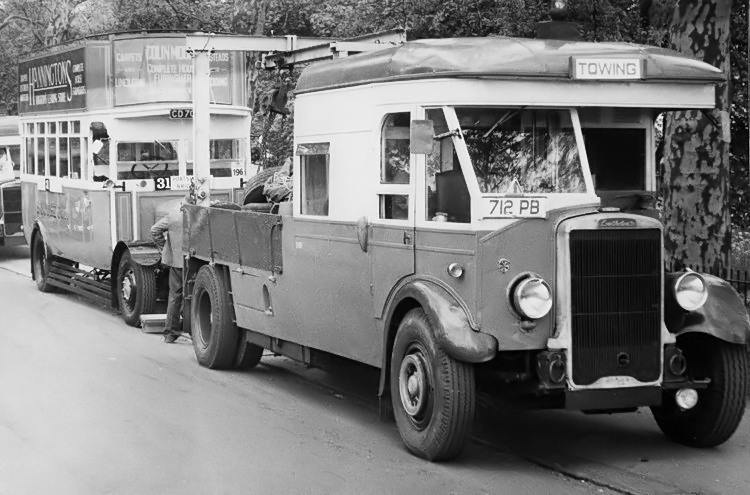
0181 rescuing Southdown G7 (CD 7045).
"In this picture Peter Burton, who owned 0182, is preparing to put on the rigid tow bar I converted from the swan-neck that Southdown had put in to support the rear gantry on 0181 for suspended tows, with just two chain hoists to lift the front of the bus and an A-frame to keep the suspended bus away from crashing into the back of the breakdown tender."
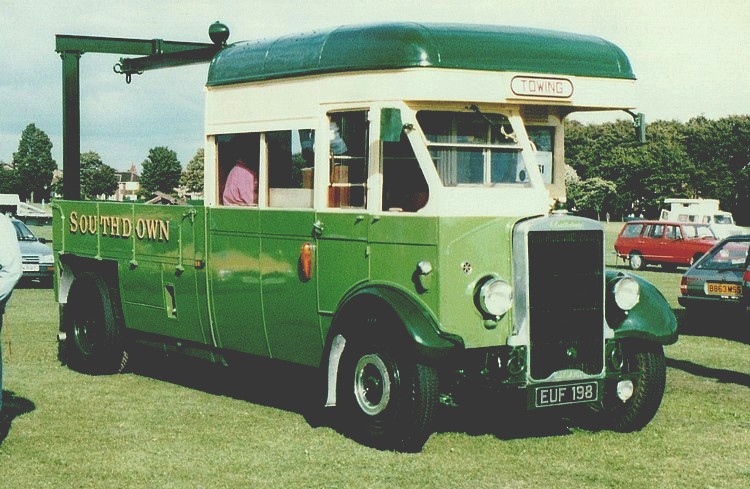
Harold Peers' tender 0198, another 1938 Leyland TD5 conversion.
"Another preserved Southdown breakdown tender is Harold Peers' 0198 (EUF 198), also converted from a 1938 Leyland TD5 and which had been based at Eastbourne garage. For the record 0198 was at Eastbourne, 0181 at Edward Street Brighton, 0825 at Worthing, 0184 at Chichester and 0182 at Hilsea. This is the original allocation, with an American ex military Chevrolet (097 BP) at Horsham. Later 0184 replaced the Chevrolet and 0825 went to Chichester. A new AEC Matador was built for Worthing."
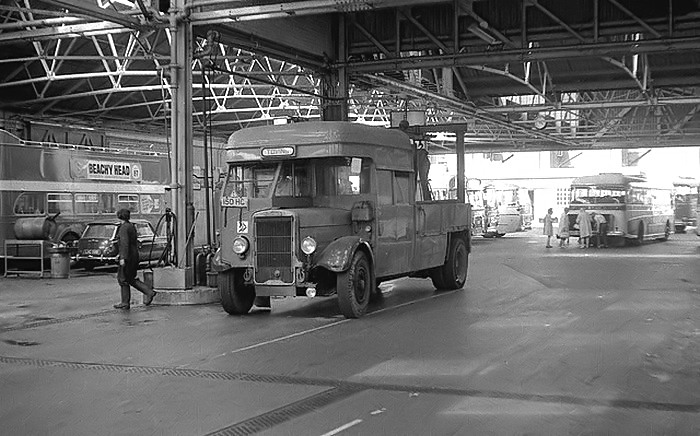
Tender 0198 at Eastbourne (Cavendish Place) depot and coach station during NBC days.
"I remember Harold coming down to Sussex for some event at Worthing and leaving 0198 at Amberley for security overnight. I went up to meet him and guide him through the Sussex roads and he said, "Well, why don't you drive it anyway?" I got in the cab and off we went. On arrival at our destination he complemented me on my driving and said, my word, you certainly know how to drive one of these! Harold lives in Bradford just up the road from me. We met some years ago and have stayed in touch."
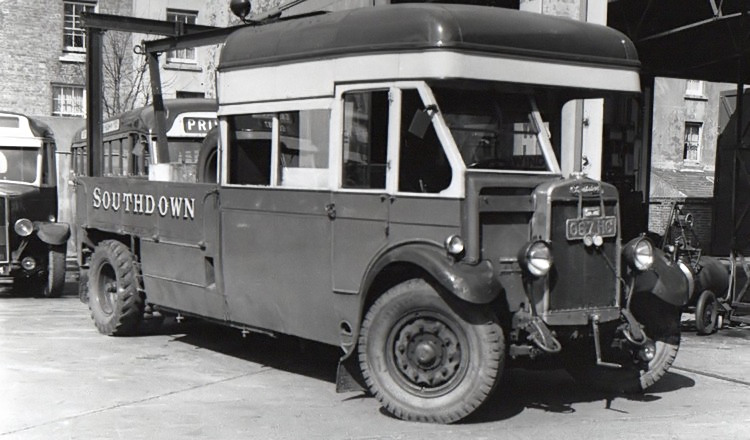
Here we see Leyand TD1 UF 6472 as converted to a breakdown tender and wearing trade plates 067 HC. That's an Eastbourne plate, and it was reported to have been based there in the 1940s/50s, but this doesn't look like Eastbourne to me, and other reports suggest it might have been based at Bognor by 1954. The body was later transferred to 1930 Leyland TD5 EUF 198 to become 0198, now owned by Harold Peers (see above). The photo is from the Clifford Jones collection, courtesy of the Southdown enthusiasts club.
"We had a line-up of 0181, 0182 and 0184 at Horsham when I drove 248 (GCD 48) on the 69 route from Horsham to Bognor Regis with the Southdown enthusiasts club, with 547 running as a relief. We took 0181 in case of breakdown and 0182 for the fun of it, then created the line up as they stayed there all day."
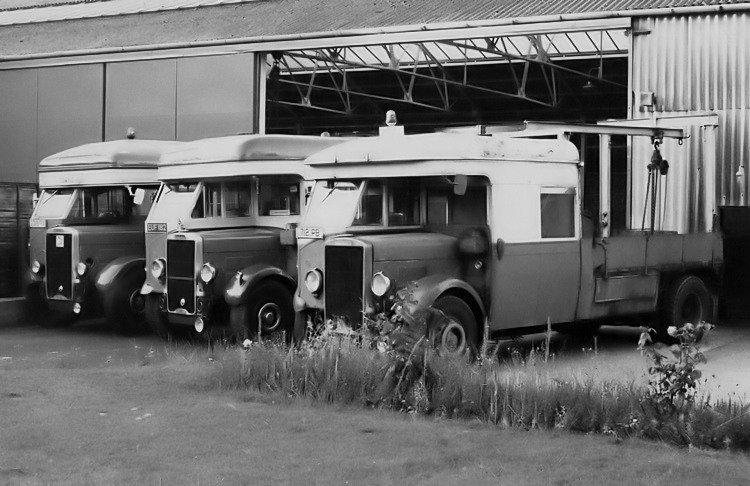
Southdown breakdown tenders 0184, 0182 and 0181 lined up at Horsham depot.
"0182 has been sold to Winkleigh and fully restored/repainted again although - shock-horror - it was turned out in Exeter colours for a short time. Simon at Portsmouth has fended off a number of buyers for 0181 since his fellow preservationist died. 0184 that Stagecoach donated to Amberley Museum is in fine fettle and appears at rallies and on the London to Brighton run."
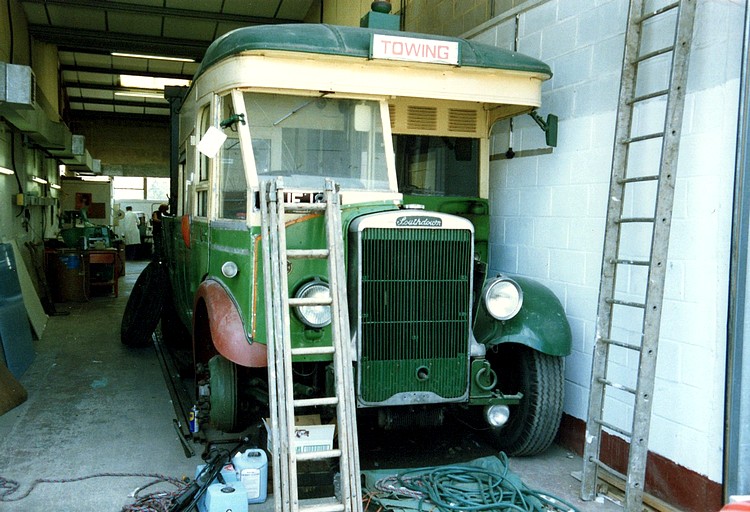
0181 in Clifford's factory.
"This picture of 0181 in my factory is the last time we did any work on her, as the front offside wing has been replaced by Norman Hamshire, who was working for me by then. She went to the chicken shed from here to do the interior woodwork, but got sold before that was finished. It was bought by two enthusiasts when I was very busy working in Abingdon making everything out of perspex, which was my occupation. It's in store at Portsmouth now, as the leading figure died leaving Nicholas Payne as the only custodian."
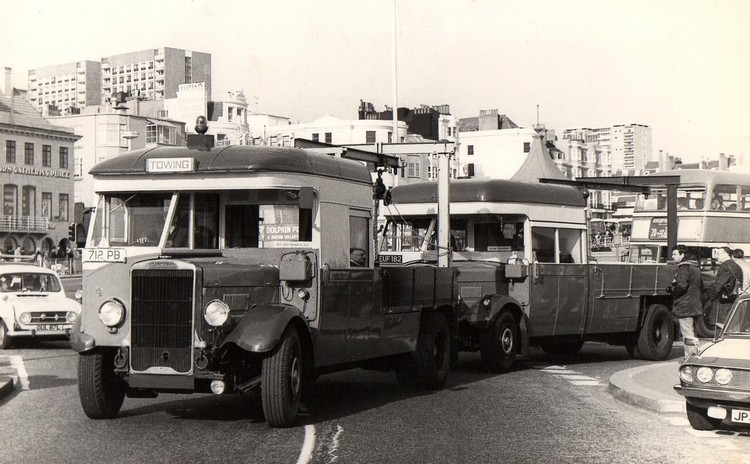
0181 towing 0182 off Brighton seafront after it blew a head gasket.
"One final tow was a very public one with 0182. When 0181 was restored I used to attend rallies as a tender for our entrants and the H. C. V. S. London to Brighton run was the best one - except this one. All went very well until we got down near the half-way mark and Peter said that 0182 was off-colour and running a bit warm. He wanted to finish the run (which he did) and, when it was parked up on Madeira Drive, the problem had surfaced. She had blown her head gasket and oil and water were mixed in the radiator. It was agreed that 0181 would tow her home to Farnham in case of any further deterioration, or damage would occur. So that is how a picture was taken by an enthusiast who took great pleasure in sending it to me."
"After another London-Brighton run I drove past the line of commercials and went up the ramp to head for Edward Street garage. Sure enough Basil was there, who was the fitter who had tried to repair the bottom end of the engine. It was a standard E102 pre-war 6-cylinder Leyland engine used in the later TD and TS vehicles. The 8.6 litre Leyland oil engine was a very smooth running direct injection engine giving 94 b.h.p. at 1900 r.p.m., making it the fastest running direct injection oil engine at the time."
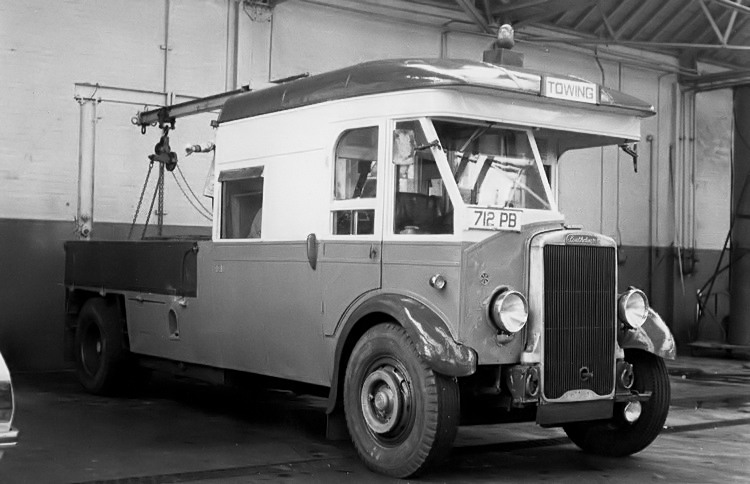
0181 returned to Edward Street Southdown garage, Brighton for the staff to see the restoration.
"It had, for the enthusiast, a very individual roar that made it so distinctive, especially from the post-war engines that emerged on PS and PD models. Basil was absolutely amazed to see Betsy again, especially restored to a good standard with new drop sides and roof, where the canvas used to be which was replaced in my drive at the house in Midhurst by Bob Gray, who has done such a fantastic restoration job with what is now Leyland PS1 Tiger HCD 449 (numbered 1249 as a coach, becoming 649 as a bus and D689 as a luggage store). He took the destination blind out of GUF 727 when he scrapped it for spares, as it had a bus full-size blind box."
"He promptly asked me if he could take it around the block and off he went! It was the highlight of his day, as he had a beaming smile when he came back through the back entrance, having gone around the Old Steine. Basil became a colleague when, later in my career, I worked for Brighton and Hove as an inspector and Basil was the foreman at Whitehawk garage."
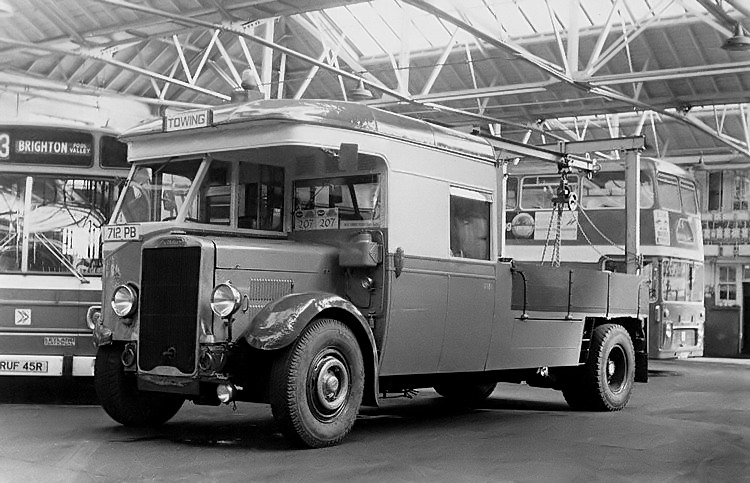
0181 returned to Edward Street Southdown garage, Brighton for the staff to see the restoration.
Clifford explains the use of trade plates. "Each depot had a trade plate for their breakdown tender, e. g. my 0181 always carried trade plate 184 CD. The Eastbourne tender had trade plate 067 HC on it as a TD1, and 150 HC as a TD5. This was probably due to Eastbourne requiring more trade plate(s) and they got swapped, but HC is Eastbourne whereas CD on mine was Brighton. When 0184 was based at Chichester it would have had 339 PX on it, which was transferred to the AEC Matador when it came to Chichester, as the Chevrolet was retired at Horsham which had 097 BP on it. The slotted brackets above the windscreen were just in case they were temporarily needed elsewhere or went to another depot. Trade plates were never permanently fixed to a vehicle, as in some cases in the trade they were in rubber mounts to be hung on a vehicle."
"Just to complete the picture, trade plates were originally general or restricted. 184 CD on mine is always photographed with general trade plates, which had a red background and white letters, so they could be used on any vehicle, and it was permitted to carry a load. This was to facilitate the breakdown tenders going to Portslade to pick up engine/gearboxes etc. which was the intention of the gantry system. When general plates were withdrawn, restricted plates - red letters on a white background - could only be used and no load could be carried. Finally the privilege of using them on breakdown tenders was withdrawn and the original number plate had to be put back."
The transition from a hobby to a profession started with Clifford managing a coach brokerage in Guildford for a while, while the boss set up in Trathens Travel Services yard at Plymouth. It was in 1977 that Clifford joined Trathens. He worked out of their Brentford depot on private hire, the express service from London to Plymouth, and European Shuttles to Spain via L'Orange depot.
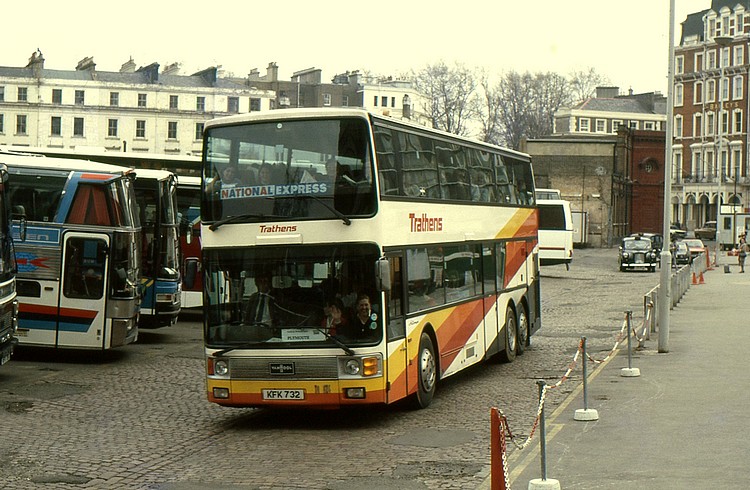
Trathens KFK 732, a Van Hool TD824 Astromega on its way to Plymouth. Photo by kind permission of Paul Statham. Clifford says, "The location is Gloucester Road coach station. The temporary portakabin in the distance is at the back of Gloucester Road underground station and was used by Trathens as an office. The mews, which was cobbled, had the houses knocked down and was used as a temporary coach station for some years, as it went diagonally across to Cromwell Road where it joined with Ashburn Place. It's unrecognisable today, being occupied by a block of flats and a Waitrose supermarket."
"My most boring shift was to be a feeder driver at Gloucester Road coach station, which was behind the underground station in an old mews where the houses had been demolished and tarmacked over, leaving the cobbles as the original street. When a Trathens coach on a Rapide or National Express service would arrive, I literally took over from the driver and drove it to Victoria Coach Station. This was at the arrivals at Samuelsons' old place. We'd get the passengers off, take the coach down to the embankment, sometimes with a very nice hostess staying on board, and layover for 90 minutes. After a few cups of coffee and whiling away the time, we'd take it back to Victoria Coach Station and argue with the inspectors how early I could get on the stand for the Plymouth departure. Once the passengers and luggage had been loaded I drove it back to Gloucester Road where the driver took over, having had his necessary break."
"I later moved to Bergland as Trathens were in trouble with the Department of Transport. Bergland International of Watford had a parent company at Seefeld in Austria. They had six Neoplans based in the U.K. at the old Marples Ridgway depot in Watford goods yard."
"Following a period of detachment from buses, my professional career took a turn for the worse when interest rates hit 18% and I was made redundant at the same time. My wife and I had to rent out our house and, as she was a nurse, we were fortunate to have a bungalow in the hospital grounds at Midhurst made available to us. My mother had been a great supporter of all things that I wanted to do and discovered that I really wanted to do something professional in the bus industry rather than driving, so she offered to buy my first bus."
"I had already established good relationships with Southdown management during the management buyout period so I approached Richard Alexander at Worthing depot and asked him if he had any of the old Queen Mary PD3s. Curiously he asked me what I wanted it for. When I told him, he said, "I've got one up at Henfield garage, go and have a look," which I did. What confronted me was a very sad looking bus on which cannibalisation had started, so there were various bits missing. It was in N.B.C. colours and, not to be too critical, it was very weathered, falling short of the green slime."
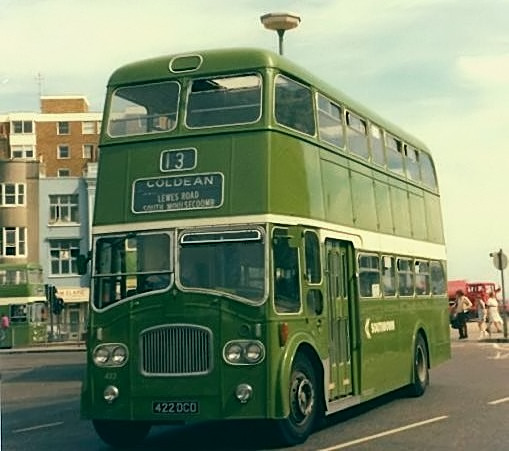
422 at Brighton in its NBC days.
"So Southdown PD3 convertible 422 (AOR 157B, although now restored to its original registration 422 DCD and which regularly appears at rallies as such), which had served at Brighton and Hayling Island, started Leisurelink at Gatwick in 1992. I bought her without wing mirrors, driver's seat and various passenger seats. Some sources say she was cannibalised at Chichester and then went to Worthing for restoration as part of my purchase deal. I saw her at Henfield in the open."
"I started up a professional stage carriage company called Abacus Carriage Services Ltd trading as Leisurelink, which began in a farmer's barn at the end of the Gatwick runway. The name was a necessity as I was working in a farm office with Abacus Computer Services and answered the phone as Abacus! It saved a lot of money at the time. Private hire proved lucrative and an ex Southern Vectis open top Lodekka (MDL 954) was borrowed from Derek Priddle to service that and provide a spare."
"Matthew Arnold contacted me and asked what I was doing up at the farm, as he had an ex Devon General convertible Leyland PDR1 Atlantean doing nothing, but which needed finishing off and the roof collected from storage. So we acquired 928 which was eventually joined by 925, which came without a roof, it having been scrapped. That was the start of Leisurelink that moved down to the London Country garage at Crawley for a time and then to the Stagecoach garage at Worthing where the roofs were always taken off and on and stored for us. Later we moved to Newhaven and ended up with 22 buses and £300,000 of East Sussex contracts, and the same again, if not more, as revenue."
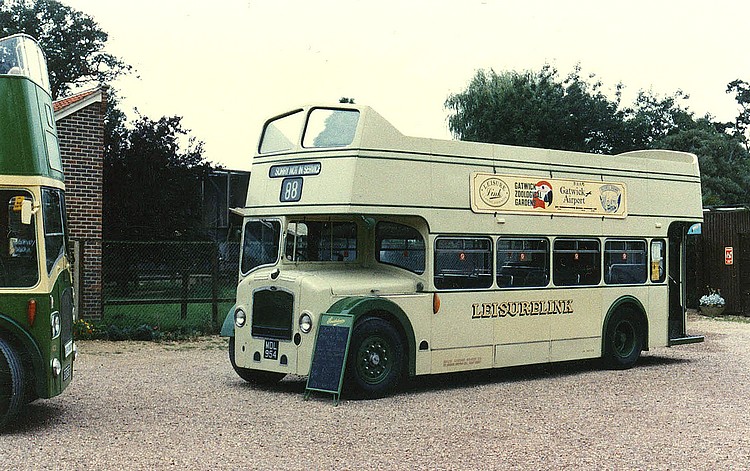
Derek Priddle's LD6G Lodekka MDL 954 had previously been with Southern Vectis on the Isle of Wight. Seen here at Gatwick Zoo in July 1992, Clifford says it was parked there to advertise the service 88 between the zoo and the Bluebell Railway. Photo by kind permission of Michael Wadman.
"Coincidently I have been in touch with Ian Coyle, operations manager / driver recruitment and training at Metrobus / Brighton and Hove Bus and Coach Co. who was a colleague on the rapid response unit at Brighton and Hove during 1999-2001. He was appointed manager of Whitehawk Garage which I applied for, and later took over the Metrobus garage (ex- London and Country) at Crawley who are in the same Go Ahead group. Obviously he has returned to Conway St., a full circle."
"The story has a happy ending as I went back and negotiated a reasonable figure for the bus to be put back together again, painted in Southdown colours, with my Leisurelink name in the same font and a class 6 test on it. I was very pleased on the day I went to collect it. I wrote out a cheque for Southdown Motor Services Ltd., drove it up to the farm at the end of the Gatwick airport runway and pondered what to do next."
"I entered into discussions with Gatwick Airport, who seemed encouraged by an idea to get delayed passengers to local attractions by way of Gatwick Zoo and the Bluebell Railway. Setting this up meant applying for an operator's licence and acquiring a second vehicle, with all the other aspects in place. During this period all the vouchers etc. for the airport were printed and an arrangement was made for Midhurst Coaches (my local friendly operator) to be the traffic manager."
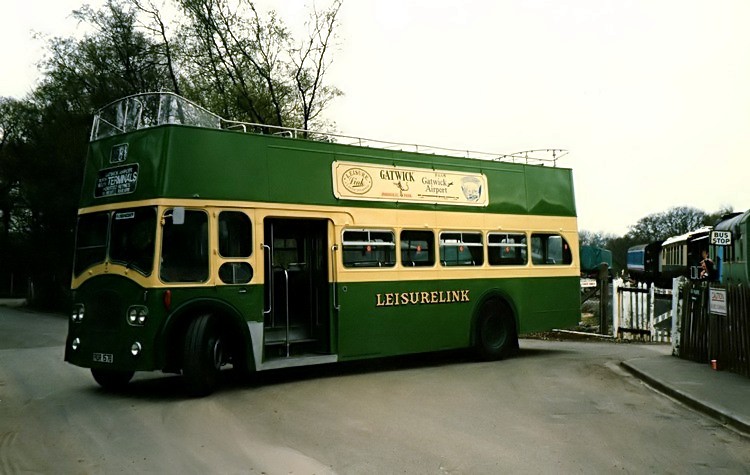
422 at the Bluebell Railway.
"The image of 422 above at Bluebell shows the start of Leisurelink in 1992, with the service from Gatwick Zoo via Gatwick Airport to the Bluebell Railway at Horsted Keynes. The reversing at Horsted Keynes station is shown, and below is a crew photo with me in the centre, my son as conductor on the right and a friend who drove for us on the left. We started the service on hire to London Country as there is a sticker in the front screen, so our application was in the pipeline and the manager of Crawley garage helped us out."
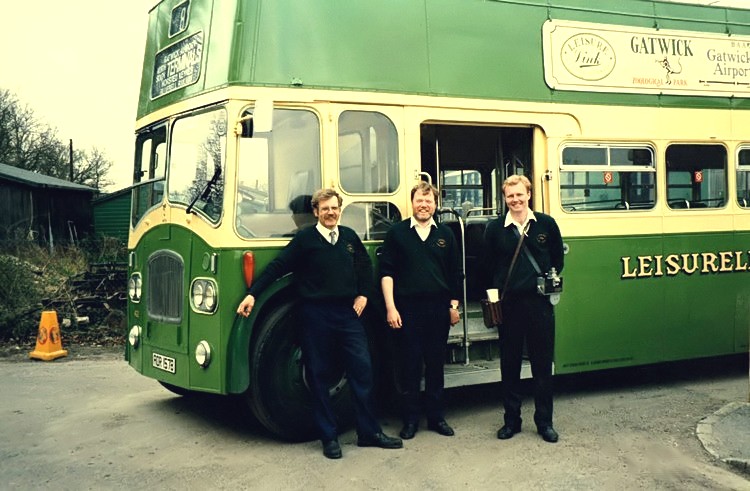
422 at the Bluebell Railway.
"During this initial period Matthew Arnold introduced himself to us and offered his ex-Devon General PDR1 Atlantean 928 GTA that was a convertible open topper, so it was repainted in a slightly different version of Tilling Cream and a Tilling Green cant-rail which, in reverse, became the norm for our fleet except, of course, our PD3 which stayed in Southdown colours. 925 was added to the fleet around this time when Winkleigh told us it was for sale as it was stored outside."
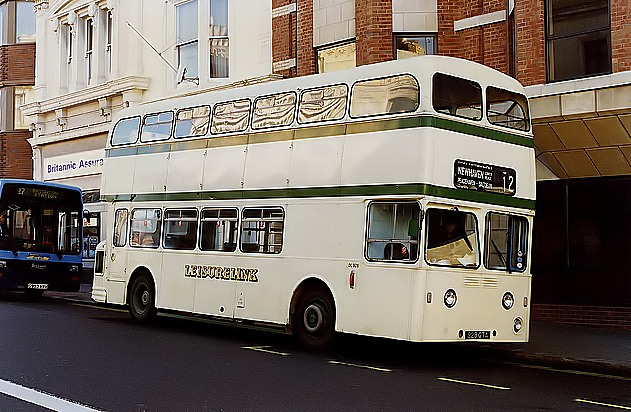
928 laying over at Brighton Station in 1996.
"At the last minute Gatwick Airport reversed their agreement and advised us that retail development was to be expanded, so they wished to keep the passengers in the terminals to spend money. It was run for a second season, against my better judgment, with a second leisure service (no. 439 which was funded by Surrey County Council) from the bottom of Box Hill on the A24 to Gatwick Zoo via Brockett's Farm."
"It was not to be, so the open toppers moved to the Stagecoach garage at Worthing where the roofs were stored, and a circular ride was run from Brighton Pier opposite Pool Valley on an established bus stop. This was after reaching a working agreement with Guide Friday, following a standoff, as we originally used the old excursion stand in Madeira Drive. The route forward along the sea front turned right up to the clock tower and on to a right turning that took the route down to the Old Steine. It followed the route above until the 180 degree right turning to get back to Madeira Drive, and then returned to the starting point."
"There came a point when I was phoned up by East Sussex County Council who stated that, as I was a bus company, they were sending me a tender for some school contracts that had been surrendered by Haven Bus. This led to a turning point in my career, when I was phoned again and advised that I had won two of the contracts. I declined on the basis that it was only profitable on three contracts, with additional revenue competing with Brighton and Hove / Stagecoach on the 712 from Newhaven to Brighton. To my surprise the answer was that the phone call was confirmation of the contract, and there was no backing out! A week later I was relieved to hear that Eastbourne Corporation had surrendered their contract so I had all three."
"The target date was to start in six weeks' time, so I had only that time to assemble a serviceable number of suitable vehicles. Vintage Yellows at Bournemouth had given me some even worse news that Brighton Corporation had blocked the sale of some Fleetlines to me, so I was stumped. A call to old friends at the Scottish Bus Museum secured the loan of two ex A1 vehicles - a Volvo Ailsa and a Daimler Fleetline, and an ex-Bournemouth Fleetline became available at a Kent dealers."
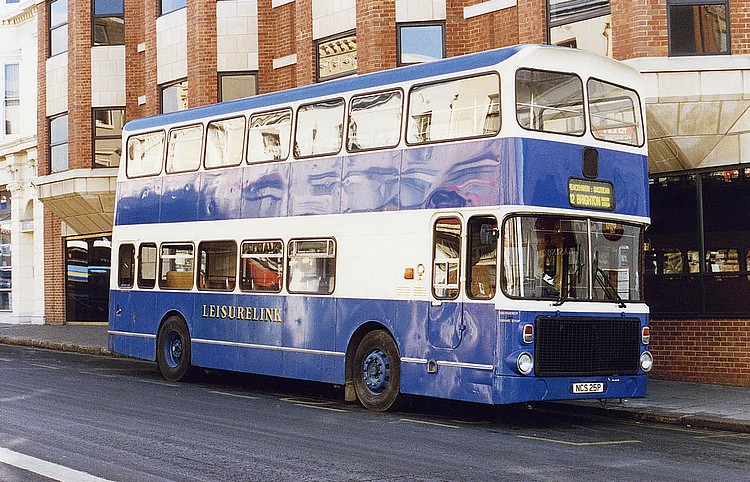
Former A1 Volvo Ailsa NCS 25P, seen in February 1996 on route 12 in Queen's Road, Brighton. Photo by kind permission of Michael Wadman.
"So, with this motley collection and the open toppers re-roofed as spares, the operation started in a yard in North Quay Road, Newhaven, provided by a friendly transport company. A Portakabin served as our office and 925 stayed under cover at Worthing during the winter. The first year saw a steady growth in our bus company with the vehicles receiving some tlc long with the A1 vehicles that sported our fleet name. My occasional shift with 422 gave me an opportunity to get out of the office sometimes as we, through necessity, had moved to Haven's old garage for better facilities. East Sussex had thrown all they could at us, including a short time on the 56 with some unreliable leased minibuses - Freight Rover Sherpa / Carlyle, former National Welsh and Merry Hill Minibuses of Birmingham."
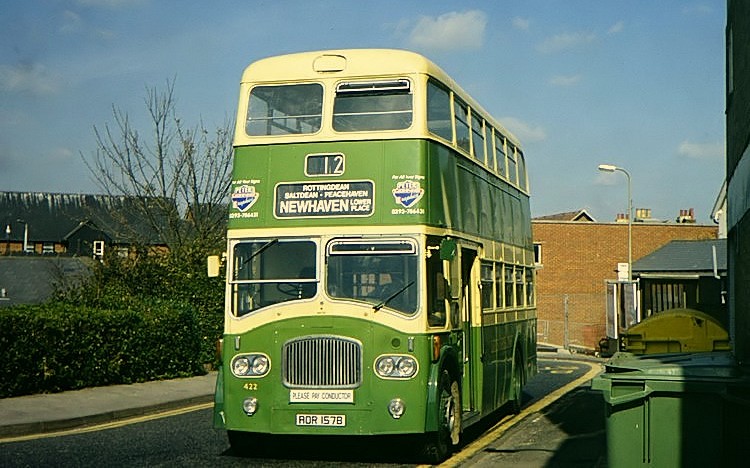
Clifford provides background to the picture above of ex-Southdown PD3/4 No.422. "I bought this slide which shows the vehicle that started Leisurelink. It's unusual to see her on the 12 as, being crew-operated, it would be me driving as I was the only one usually with a manual licence. I would have to grab one of the cleaners to conduct. Occasionally it would work into Brighton on the 12 to do the open-top rides off the bus stop opposite Pool Valley, which was very popular, but we would never miss the opportunity for more income. However it's showing Newhaven on the blind so it must have just arrived at Newhaven and so would be doing a 12 shift, possibly having done the 114 School Service Seaford to Cardinal Newman School which was the first journey and it would then have worked back to Newhaven on a 12. It would lay over before doing another Brighton."
"The turning point in the life of Leisurelink came after a major reshuffle of contracts with the emergence of Brighton and Hove becoming a city. We were drawn into the re-tendering scheme with a view to targeting the 56 with a couple of new midi-buses and a second-hand spare. Our luck had taken a turn for the worse, as we ended up with the school contract for the local secondary modern and a number of other minor contracts, including our existing schools on the coast road and a couple of East Sussex ones with their loan vehicles."
"This ramped up our overheads and involved buying on lease/purchase twelve ex West Midlands Fleetlines, fortunately with Gardner engines. All seemed well until a few months later we found three of the buses had rotten bodies which impacted on our availability. Vintage Yellows had supplemented our fleet with a rare Atlantean AN53 and some ex Bournemouth Fleetlines, but the age of these took their toll on our resources as experienced fitters were at a premium - we were surrounded by reputable companies having the pick of the local available skills."
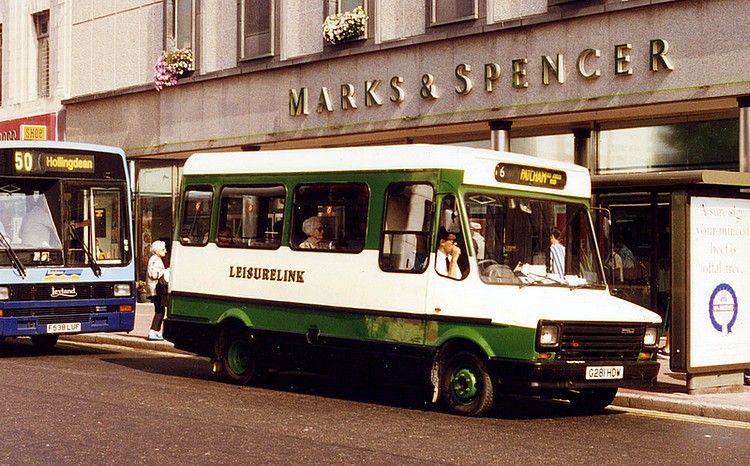
Former National Welsh Freight Rover Sherpa G281 HDW seen working route 56 in July 1996 in Churchill Square, Brighton. Photo by kind permission of Michael Wadman.
"A final move was to give up 30% of our company to Metrobus, as I knew the principal partner through part-time driving with Tillingbourne Bus Company in Shalford. It was on the basis of an injection of capital and servicing of our better vehicles, plus some loan. Behind the scenes discussions took place with Brighton and Hove and, within a month, our minority shareholder closed us down. This put Brighton area back into the hands of the incumbent operator with no competition."
"One sad emotional day in 1997 was when I had to decide to close the company. We took everything off the road one Friday afternoon at 5 p. m. The staff would not go home! They all stood around saying, couldn't we work for a couple of weeks for no wages?. That made me a very emotional, even though the revenue had dropped to £80 per bus per day, which had no accountable reason even though our loadings had remained steady."
"After Leisurelink I joined Brighton and Hove and ended up as a revenue protection officer in a rapid response unit like Starsky and Hutch! After being threatened by a 14 year old with a knife one night I decided to leave, and in 2001 I joined Stagecoach Oxford, bus driving on local routes. Note that I worked for Stagecoach but my partner worked for Go Ahead on Oxford Bus Co, and we ended up on the same route competing with one another! I did the city centre first, then it suited me to do rural late evenings."
"Meanwhile when my partner and I left Brighton and Hove we bought a canal boat to set it up as a hotelboat and it grew to The Away Group in Birmingham in the early 2000s. I'm actually in the video as the skipper on Away2dine. This is why I have an email signature as old canal man. We collected the boat from Acton Bridge and took it to Leamington for a steam clean and bottom paint then we spent the winter at Thrupp near Oxford."
"While it was being converted at Thrupp by a couple who had joinery and upholstery skills and also lived on a boat, we went... yes, you guessed it ... more bus driving. All these were on a flexitime arrangement - we gave the depot our availability and they allocated us shifts."
"In 2002 I moved to Stagecoach Leamington, again bus driving on local routes and from Stratford upon Avon to Coventry. In 2003 I was loaned out to Stagecoach Banbury, again driving local routes, due to an acute shortage of drivers, to the point that they were dropping services. We were paid expenses while we were travelling down there until we moved the boat to Lower Heyford."
"In 2004 I did route learning for a couple of weeks with Mike De Courcey Travel (Travel de Courcey) of Coventry. I knew the manager who my partner and I had worked with at Stagecoach in Leamington Spa."
"I later found time to work for Flights Hallmark in Birmingham. Driving their Volvos and Neoplans in Europe was very enlightening, as was the whole aspect of it. Part time and full time work when I was between jobs was my saviour, and included National Express from Wolverhampton to Gatwick, and park and ride at the N. E. C. My last turn at the wheel was in 2006 with a Flights' Neoplan doing two round tours of England and Scotland back to back at Heathrow Airport on Christmas day. But the height of my career was Leisurelink."
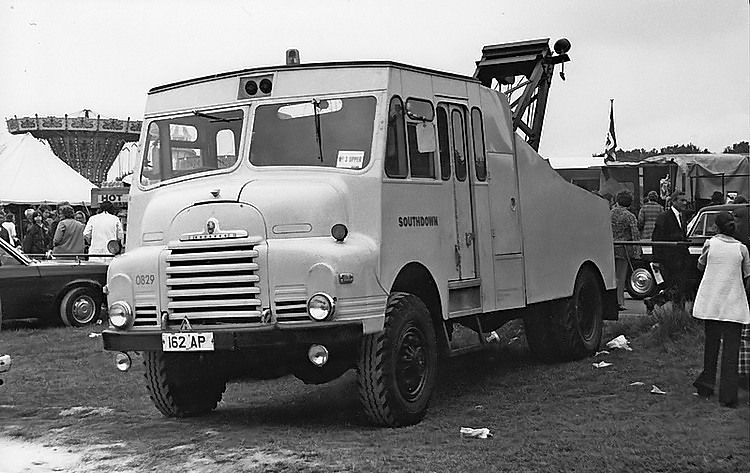
Southdown green goddess tender at the Derby.
"This Southdown Bedford green goddess at the derby is an example of the vehicles that replaced the Leyland TD5 breakdown tenders. I have found out that it was John Piper, who started with Southdown as an apprentice and rose to assistant chief engineer and who sold me D689, disposed of the TD5s and purchased the green goddesses, which proved to be unable to cope with the slippery garage floors when wet! This particular example is numbered 0829 and it's got the trade plates that Brighton Hove and District had on their Bristol breakdown tender, that nobody has seen since John Jerome had it."
"The advent of the green goddesses did not relieve the situation after the demise of the TD5 breakdown tenders, as they were too light and modern buses were getting heavier. The two AEC Matadors were reliable and capable until the big groups took over and decided that dedicated assets in case of need was not warranted, so recovery went into the hands of professional contractors."
"A green goddess enthusiast website has provided some information about the Bedford that replaced 0182 at Hilsea. Bedford 4x2 SHZ (NYV 495) chassis number 12251 was built in 1952. It was sold off after the A. F. S. disbandment to L. W. Vass in January 1972. It was then sold to Southdown in June 1974 where it was stationed at Portsmouth with the fleet number 0831. I'm not sure if Southdown fitted the 5 ton Turner crane or if Vass fitted it. Vass did take hundreds of A. F. S. 4x2 GGs and converted them into all sorts for onward sale. Some were even converted to gun tractors for Cyprus!"
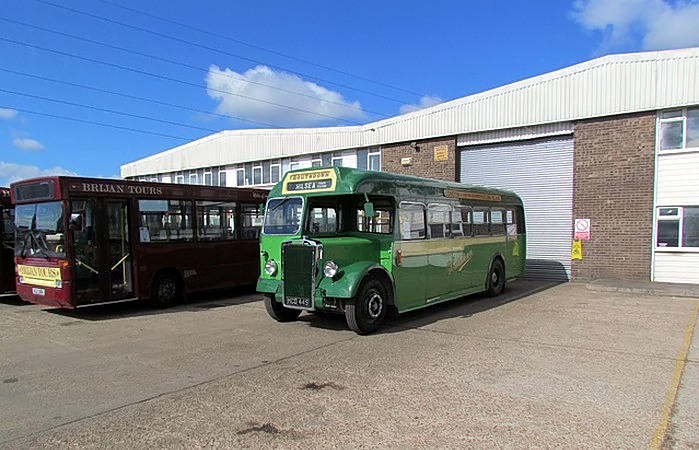
Leyland PS1 Tiger 1249 (HCD 449) at a Brijan Tours Open Day.
"The picture above shows my old bus HCD 449 on the first occasion I saw what Bob Gray had achieved. My divorce forced me to sell it, and it then passed to a buyer who stored it. He did very little with it after I had replaced the worst of the rot around the rear entrance. Bob bought it after that, and got in contact with me straight away."
"So, in simple terms, I was a boy enthusiast whose hobby, with a smattering of railways, grew into an active participation in an industry where I managed to work for so many bus and coach companies. This was because my genuine need to work in the industry at all levels was recognised while holding down a senior management position in manufacturing, including having my own business. This followed on to a situation when I operated my own bus company, which realised the peak of a career, finally full time in the bus industry. It is, I suppose, ironic that I finished all this working on the canals."
Leisurelink appendix
FLEET LIST
All the above Fleetlines were acquired from a dealer in August 1996. They were put straight into an intense repaint programme into Leisurelink colours. WDA 951T was the subject of a legal complaint from Brighton Corporation as it was still in West Midlands colours when put into service.
Vehicles provided by East Sussex County Council to operate service 123
Vehicles substituted by East Sussex County Council to operate service 123
A little known visitor from Vintage Yellows to Brighton in Summer 1996, was former Portsmouth Leyland Atlantean open topper ERV 251D which operated for Leisurelink between Brighton and Newhaven in which town it was seen on the 17th August.
Vehicles loaned out
ROUTES OPERATED FROM NORWOOD HILL / LONDON COUNTRY DEPOT, CRAWLEY
ROUTES OPERATED FROM SOUTHDOWN DEPOT WORTHING
Open Top Bus Rides from Brighton Pier (20 minute circuit). The Brighton open-top tour in 1994 ran on Saturdays and Sundays and Bank Holidays from 30th April to 25th September, increasing to daily from 25th July to 2nd September. The pattern of operation on an excursion licence continued in 1995.
ROUTES OPERATED FROM NEWHAVEN DEPOT
TRADING ACTIVITIES AS WEST SURREY TRACTION PRIOR TO LEISURELINK
689/1249 - ex Southdown 1947 Leyland PS1 ECW HCD 449. Observed in Bognor Regis depot as left luggage office 1957 - 1967, acquired 1967. Gray, Fareham?/82
0181 - Ex Southdown 1954 Leyland TD5 breakdown tender with remains of original 1929 bus body prior to conversion. Acquired ?/74 sold to Nicholas/Payne ?/95<
649 - Ex Southdown ? Leyland Beadle rebuild ex Oliver, Chichester. Sold to Gray, Fareham
5 - Ex Brighton Corporation Leyland PD2/37 Weymann Orion H37/27F, built 1961. 5005 CD.
11 - Ex Brighton Corporation Leyland PD2/37 Weymann Orion H37/27F, built 1961. 5011 CD. Sold to Lowe, Baronsworth farm, Kent in part exchange for two ex LT RTs Craven bodies with top boxes.
10 - Ex Brighton Corporation Leyland PD2/37 Weymann Orion H37/27F, built 1961. 5010 CD. Sold to G. Vane-Hunt 1/78.
Breakdown wagon appendix
FLEET HISTORIES
0181 - Edward Street, Brighton. Bought by me with no engine. Engine supplied by Dave Hoare at Winkleigh in exchange for a PD2/12 engine for an RTL at the original Cobham Bus Museum. Now in store at Portsmouth.
0182 - Hilsea, Portsmouth. Bought by Peter Burton from David Fereday Glen after towing 0181 to Milford, Surrey. Now at Winkleigh.
0184 - Chichester, then Horsham after displacing a Chevrolet truck there. Stayed in service until Horsham garage was closed and demolished. Stored at Worthing and then donated by N.B.C. to Amberley museum and now restored and regularly on the rally circuit.
0198 - Eastbourne. Bought by Harold Peers who lives just down the road from me at Bradford.
Wilts and Dorset Southdown original TD1 - This is one of the original TD1s before they were transferred onto TD5 chassis. It's the fifth one, as Southdown shared a couple of directors with Wilts and Dorset. It's now at Winkleigh and being restored.
0184 (EUF 184) at Horsham in all-over departmental green wearing trade plate 339 PX. Clifford
wonders what the driver is doing! The photo is from the Clifford Jones collection, courtesy of the Southdown enthusiasts club.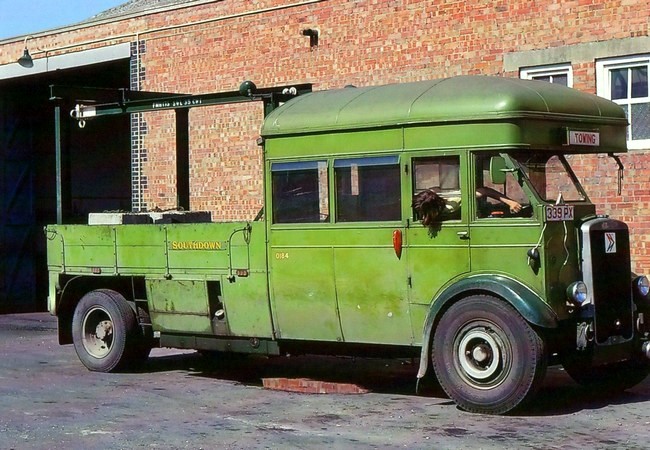
Email Events diary Past events list Classified adverts Classic U.K. Buses Classic Irish Buses Classic Manx Buses